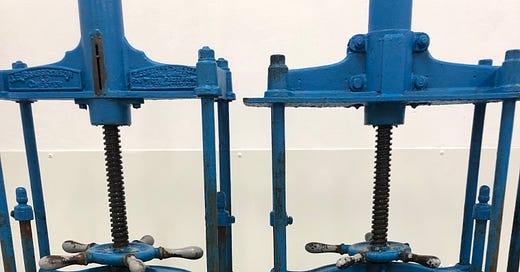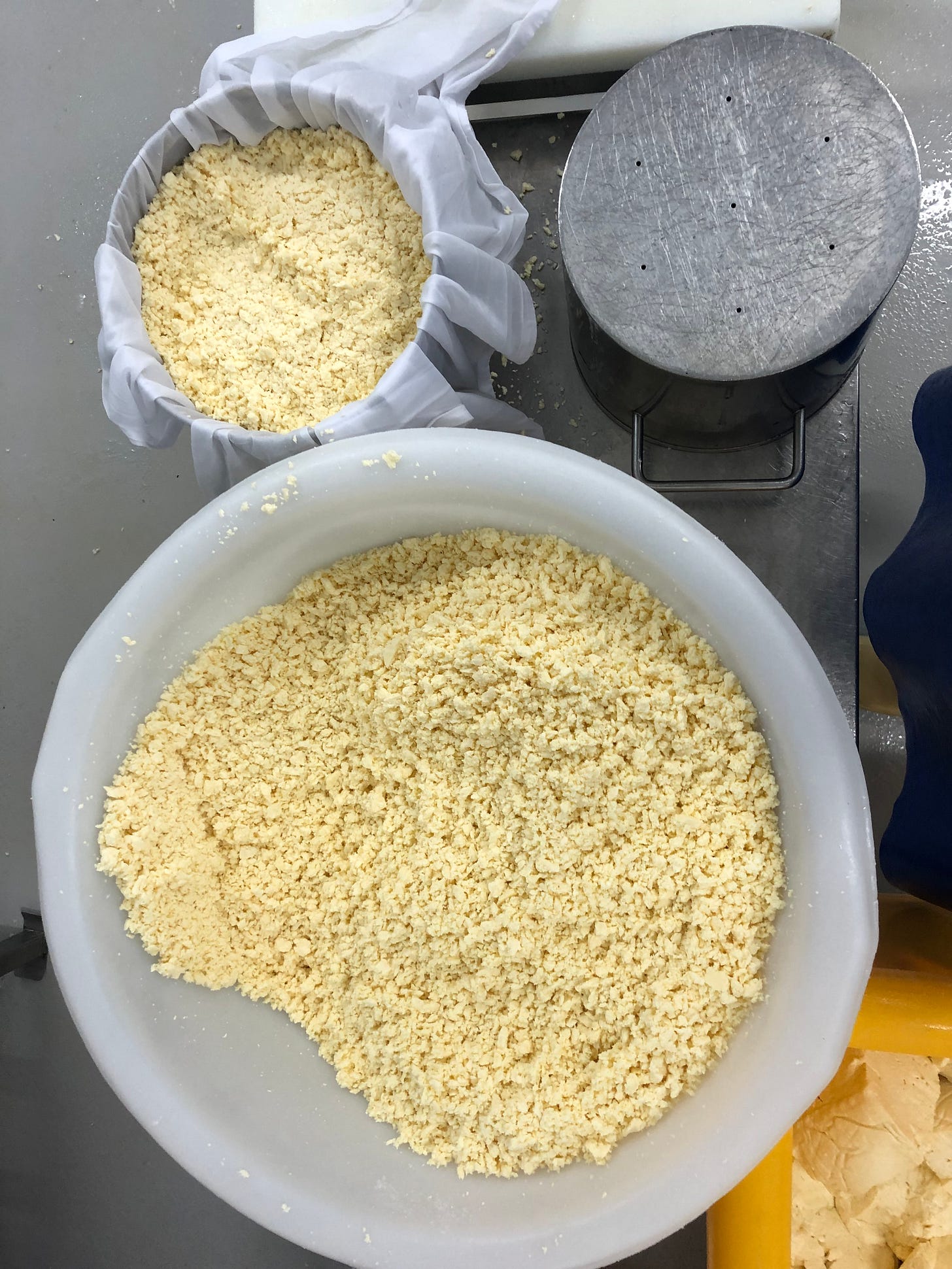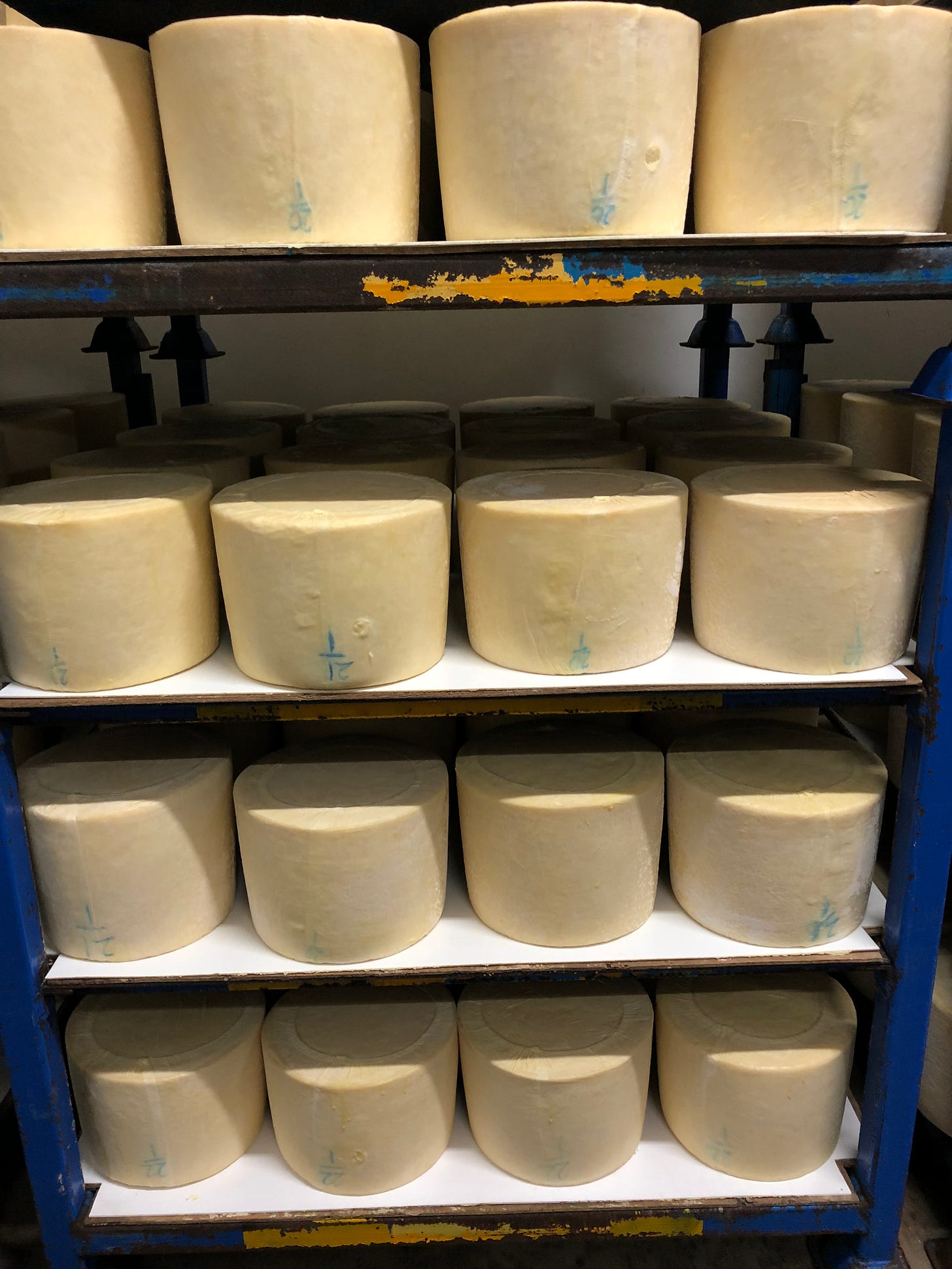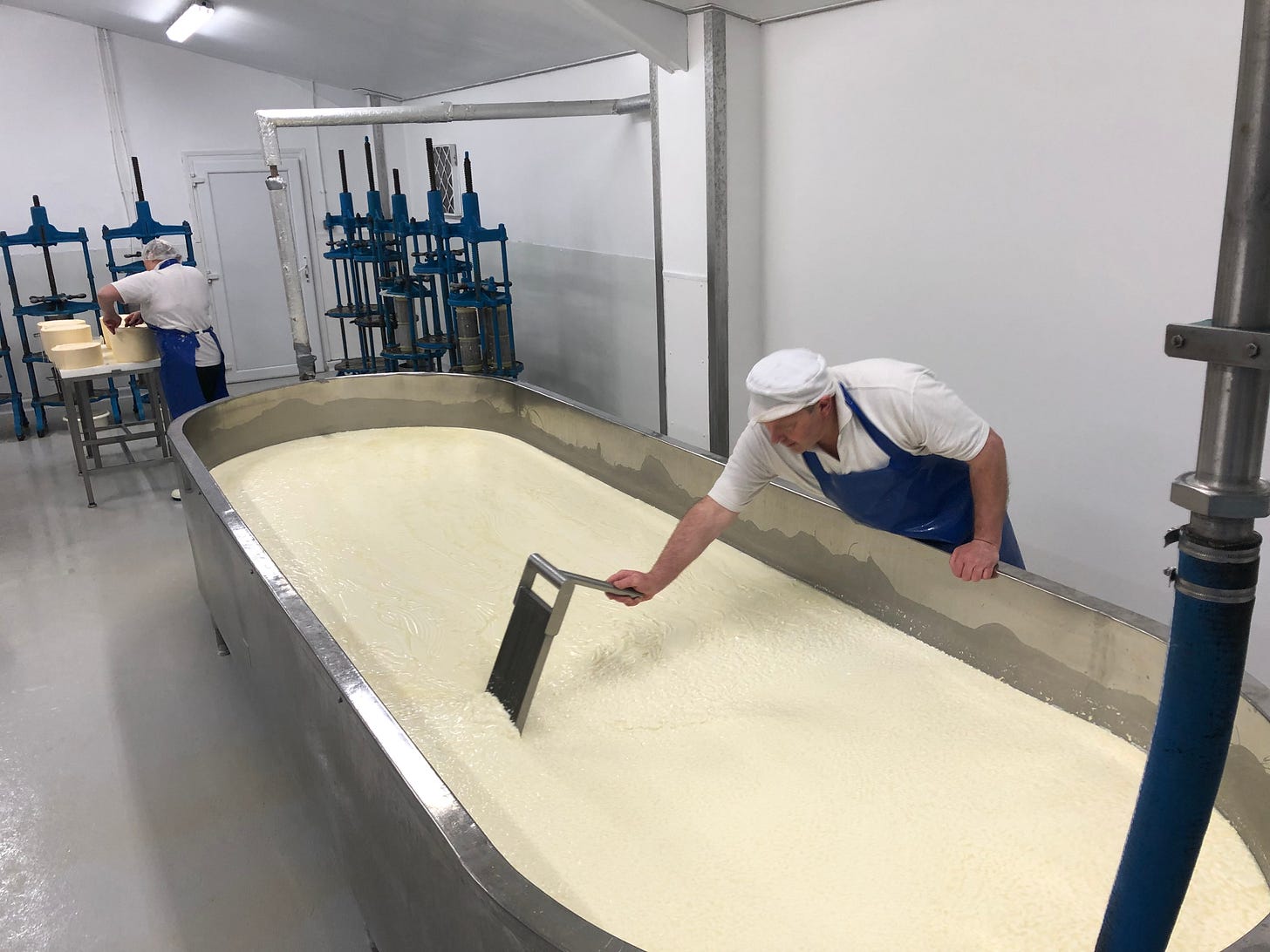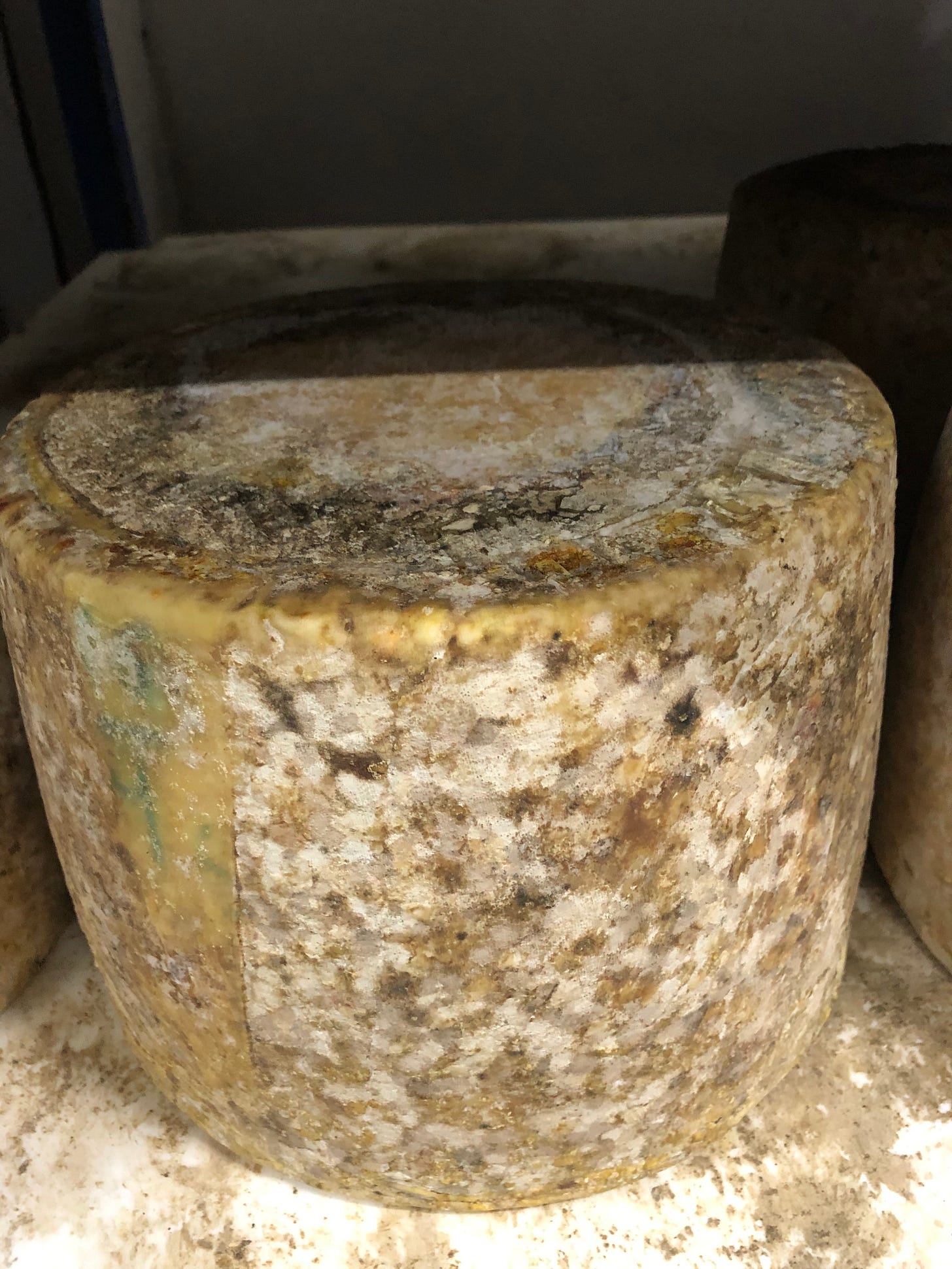I imagine that in the past it was more common for small scale farmer/cheesemakers or herders to mix curds made on multiple day into large wheels. It is still done in the cheeses aged in goat skin sacks in Turkey, Georgia, and the Balkans. Kirkham’s Lancashire, made by Graham Kirkham and his team is the only example of this phenomenon that I know of in the UK. It is made by running 2 and 3 day old curd with different Ph, aroma, and texture through a peg mill along with salt. The 10 kilo cheeses are pressed in old school screw presses overnight and butter is applied to the cloth wrapping before aging.
Why would you mix multiple days of curd together in one cheese? For Lancashire, this practice stems from its history of being made on farms with very small herds, not enough curd was produced in a day to make a single large cheese. It was the industrialization of the cheese in the 20th century that changed it from the slow fermented, multi day make to a single day, fast acid, crumbly cheese. Like most British farmhouse cheeses, WWII sounded the death toll to most of the farmhouse producers. Today there is only one farmhouse raw milk Lancashire being made. Kirkham’s Lancashire is the last of its kind. Link: History of Lancashire cheese
I had heard much about this legendary British Territorial, but I hadn’t tasted it until I arrived in London last November. The flavor is mild but full: Sour milk, Yogurt, and amplified Butter. It is juicy and mouth watering; Graham describes it as being like eating small pieces of popcorn almost soggy with butter, it melts in your mouth. It has a remarkable amount of flavor development at 2 months, and you can really taste it’s unique character in the 2 day old curd. The aging gives it more depth and allows the texture to develop, but the final flavor is just a step away from milk, cream, and butter.
Besides the sublime flavor, what is striking about this cheese is its texture. It’s wrong to describe it as crumbly as the common industrial versions of Lancashire have the crumbly texture that people associate with the cheese. It is a fluffy and flaky, variable texture galaxy of firmer and softer curd planets fading into one another in a nebulous butter cloud. It has a signature texture that I haven’t seen in another cheese, although it can be placed in the category of British crumblies. There are no shortcuts to get this texture, it is a result of the slow acidification, gentleness of handling, and the blending of various days curd that allow some breakdown and the establishment of yeast before salting. Link to Article explaining Lancashire vs other cheeses
A crucial element of the make is fresh milk, that is never refrigerated. Evening milk is held at 8C (46F) allowing a bit of natural souring before being combined with morning milk. This is significant difference from how most cheese is made, refrigeration alters raw milk ecology in a negative way. When the bulk tank was first used here and milk cooled fully, the cheese had issues with pseudomonas, a psychcrotrophic bacteria. The modern practice of cooling milk immediately and storing it up to 3 days makes it more susceptible to issues such as this. This is compensated for by pasteurization or bombarding the damaged milk with fast acting starters. A slowly fermented cheese like Lancashire requires milk with its indigenous microbial population intact.
Barbers starter is bulked up in sterilized milk and the sour milk starter is added at a very low rate, (just a sniff of starter, he says). The curd is fairly soft when cut by small hand harps, and fluffed gently in up and down motions periodically over ten minutes. Then it sits under the whey for over an hour until the curd feels right, at this point the whey is drained off. The soft curd mass gets a center channel carved out by delicate scooping of shallow layers of curd that is piled on the edges, allowing whey to pour out of the full of well defined channels. You can see a great video from 2012 of this although the process was a bit different back then. Link here: Neals yard film Kirkham’s make
After the still very soft moist curd mass has been stacked in the vat, it is cut into hunks and removed to a separate drain table where it knits back together into another mass. This mass is cut into 6-8 inch cubes and broken by hand 3 times over 3 hours. This process of breaking releases the whey from the curd mechanically, while the ph is still quite high. It then has pressure applied overnight. Since little acid has developed, the mineral content is not lost in the whey.
When the cheese is finally molded, it is made up 50% 2 day and 50% 3 day old curd. There is some yeastiness coming in, as the cheese has not yet been salted. I would imagine this yeast growth is having a positive impact on the ripening and final flavor of the cheese. A cheese like this has ample room for problems, everything has to be just right. But the realm of flavors that open up when you get textural breakdown and flavor development happening presalting is immense.
A lot of cheeses rely on quick acid development to push whey out, along with minerals (lactics). Or high heat and a fast make, getting the curd out and moulded before too much acid has developed (Alpines). Kirkham’s slowly builds up to a fairly high level of acidity over the 2 and 3 days. This cheese takes a path that is in opposition to the industrial paradigm of rapid acidification. By having a slow fermentation, “the goodness is kept in the curd” in Graham’s words. The whey is slowly lost after leaving the vat, removed by hand work rather than the action of acidification. All the forces of the modern world encourage artisans to abandoned slow traditional methods, scale it up, strive for efficiency despite the loss of quality and character. This cheese is an anachronism, it takes its time, and that’s the only way to get the singular texture and flavor.
I’d like to encourage conversation, so please let me know what you think about this piece below. Have you tasted this cheese? What other multiple day curd cheeses are out there? How do you feel about the loss of well established but never static cheesemaking techniques such as this?

